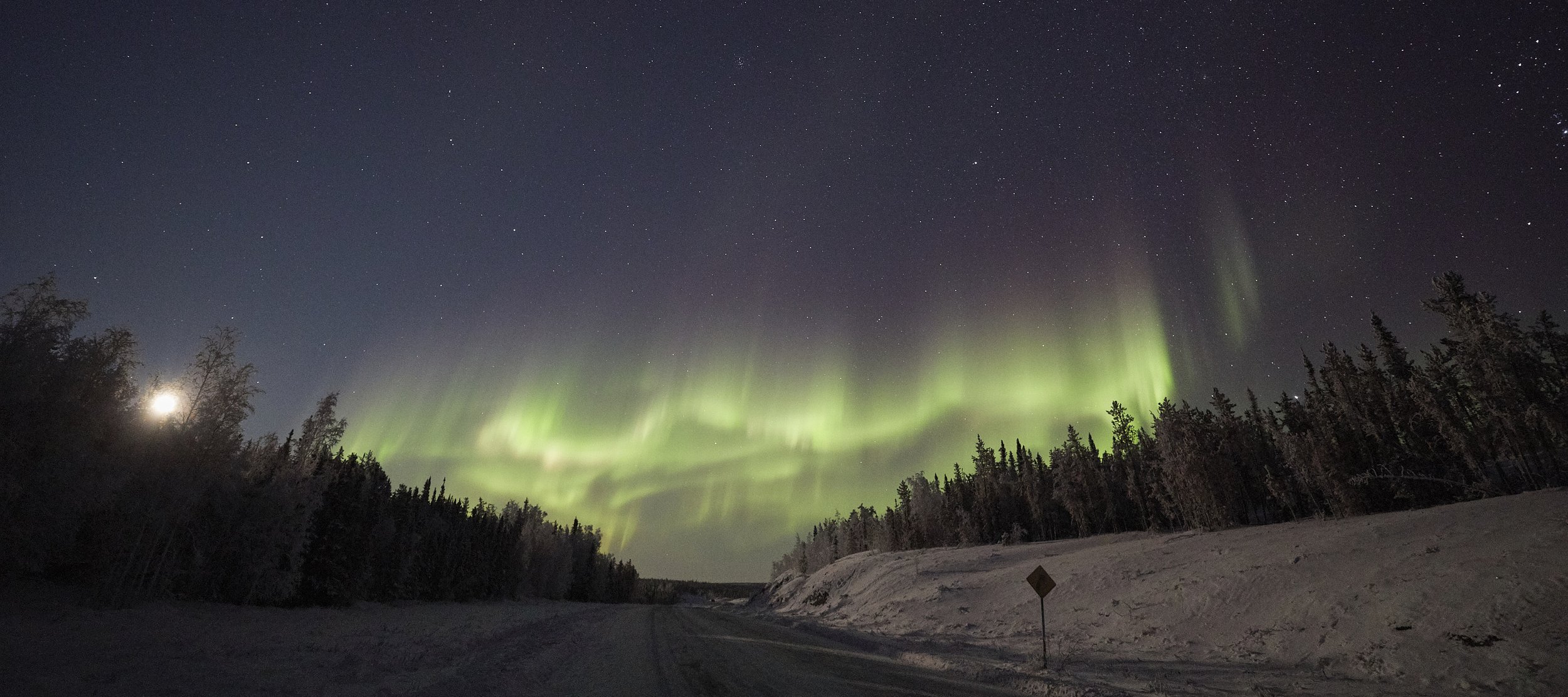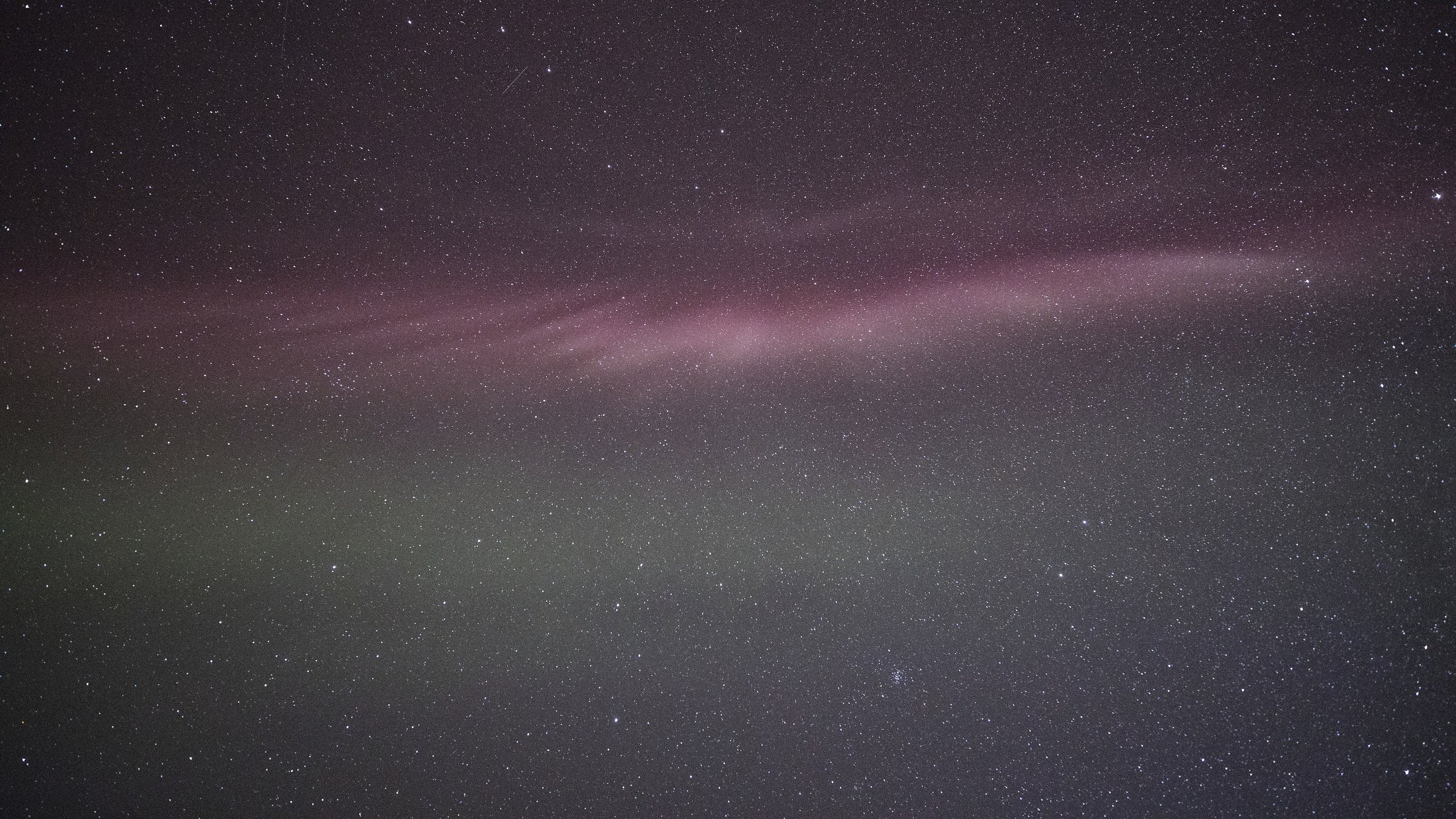
The mosquito vs. hoar frost conundrum, factoring in moon phases, understanding your eyes at night, and a few words about your plans to see the aurora in June.
Before you go
Let me break your heart right from the start. If you're planning to see the aurora in May, June, or July, you’re hoping for what is essentially a one in 11 year event.
Aurora season in Yellowknife is August through April. These are our safe zones. I've seen the aurora in the second half of July, and in the middle of May - but because of our long summer days, it’s a good idea to keep your visit from anytime in August all the way through to the first few days of May.
From the most gentle summer nights to the darkest depths of winter, 9 months of pure aurora chasing bliss from August through April await you.
Shoulder seasons
Long, warm days make it likely to experience the forever northern twilight sky with the northern lights at the beginning of aurora season in August. Reflections of the northern lights off the water will take your breath away before Winter begins her grip in November.
At the opposite end of the season - spring. Rejuvenation, rebirth, everything's blooming… all that stuff. Except March up here still sees nights of -20°C and the winds aren't exactly 'warm'. Opportunities to view the aurora under a deep twilight coloured sky again become plentiful toward April.
This can be a photographer’s dream.
The dead of winter
While there's certainly no question these months can bring us some challenging conditions, it's what coming to the north is all about. These months will provide some of the greatest payoffs in terms of your experience. November and early December may mean longer drives chasing for the aurora in the way of searching out clear skies. This to me is what this is all about, these are the nights that thrill me the most. For those -30°C evenings, you’ll want to be sure you’re bundled up in the warmest winter clothing (see my FAQ for details) and taking breaks inside the vehicle - where you can take in the aurora through the moonroof.
There's nothing like being here in winter.

Waxing crescents, waning gibbous’, full moons, new moons, and the Milky Way as you’ve never imagined.
Moon phases
Each moon phase is going to give you a very unique experience. A full, or nearly full, moon will become a significant source of light pollution - especially over a frozen landscape covered in snow - so it can make a faint aurora seem harder to see, but you are still going to see the aurora during those near full moon phases. I promise you it doesn't disappear.
Some of my favourite nights is when the moonrise or moonset is halfway through our time out on tour, and you really get to experience both having the moon in the sky but also the darkness of just pure starlight. If you take this into a photography mindset, it's really something spectacular to me. As the moon approaches the horizon, our beautifully quirky trees will cast long shadows across untouched snow on frozen lakes, and the moonlight itself will be gentle and warm.

While the moon doesn't directly affect the aurora borealis itself, it will have a strong influence on your experience, and your timing in a moon phase is worth making a conscious decision about.
Moonrise, moonset, and moon phase guide for Yellowknife

What you can expect to see, to enjoy, and how it compares to the photographs that flood the internet.
Let’s talk colour
So you've wanted to see the northern lights for as long as you can remember, or for as long as hipster Instagram accounts have been posting oversaturated photos of the someone camping on a mountain peak underneath a neon green sky, but what can you really expect? Is it as breathtaking in person as it looks in all the photos you've seen?
It’s a tricky thing to explain, so yes and no
What all this means, is as you witness the aurora, especially as you're getting used to what to look for, your eyes will usually pick up the brightness of the greens much more easily than it will the magentas, or especially the maroons and burgundies. All the colours of the aurora are visible to us, but everyone perceives differently and will have very unique experiences.
So to speak from my personal experience, there have been nights I've seen some reds. Purples and pinks; weekly, and green of course almost nightly. The northern lights can become so bright, they'll light up an entire landscape to the point, where on a moonless night, you'll be able to read a book under them. Just don't expect to see the atomic greens and neon pinks some tourism agencies like to push into print.
It’s all a lot to take in at once, eye know.
Colouring in the details
Almost any camera manufactured in the last couple years will be more sensitive to colour in dark environments than our eyes are. A faint-to-the-eye aurora can be quickly translated into more intense colours than we're able to perceive them as. This is of course true of the northern lights, and all night scenes, because of the way our eyes work.
The cones are responsible for much of the colour we perceive during the day in brighter environments, but they are much less sensitive to light generally than the rods are. So in dark environments, our rods, being so much more sensitive to light, allow us to continue to perceive in very low light environments, albeit with significantly less sensitivity to colour. Our rods also have far less sensitivity to long-wavelength light, which is why headlamps, phone star gazing apps etc. use the colour red - to help preserve our night vision - which takes somewhere in the range of 15 - 45 minutes to fully achieve.
Here is an unedited photograph I took of the aurora from my Canon 5D camera in September 2018. The ISO is 12,800, aperture f/2.8, and shutter speed 6 seconds at 15mm. The aurora in this moment was still weaker, as evidenced by having to use such a high ISO. There was no moon this night.
This is, not perfect, but that same photograph edited much closer to how I remember actually viewing the aurora in real time with my naked eyes in that moment. Very faint greens were visible, and the reds and purples were much more just a different ‘hue’ than a distinctly identifiable colour.
The aurora in this moment is very active, very strong. From my Canon 5D, the settings are ISO 8000, aperture f/2.8, and a shutter speed of just 0.6 seconds at 15mm. The difference in camera settings to the example above demonstrate strongly the difference in the intensity of the aurora. There was no moon.
To the naked eye, there was not much difference at all in the pinks and purples - in fact, the pinks at times appeared slightly more intense to the naked eye than in the photograph. The greens were still generally more muted with the eye, however the most intense areas & moments were distinguishably green.





